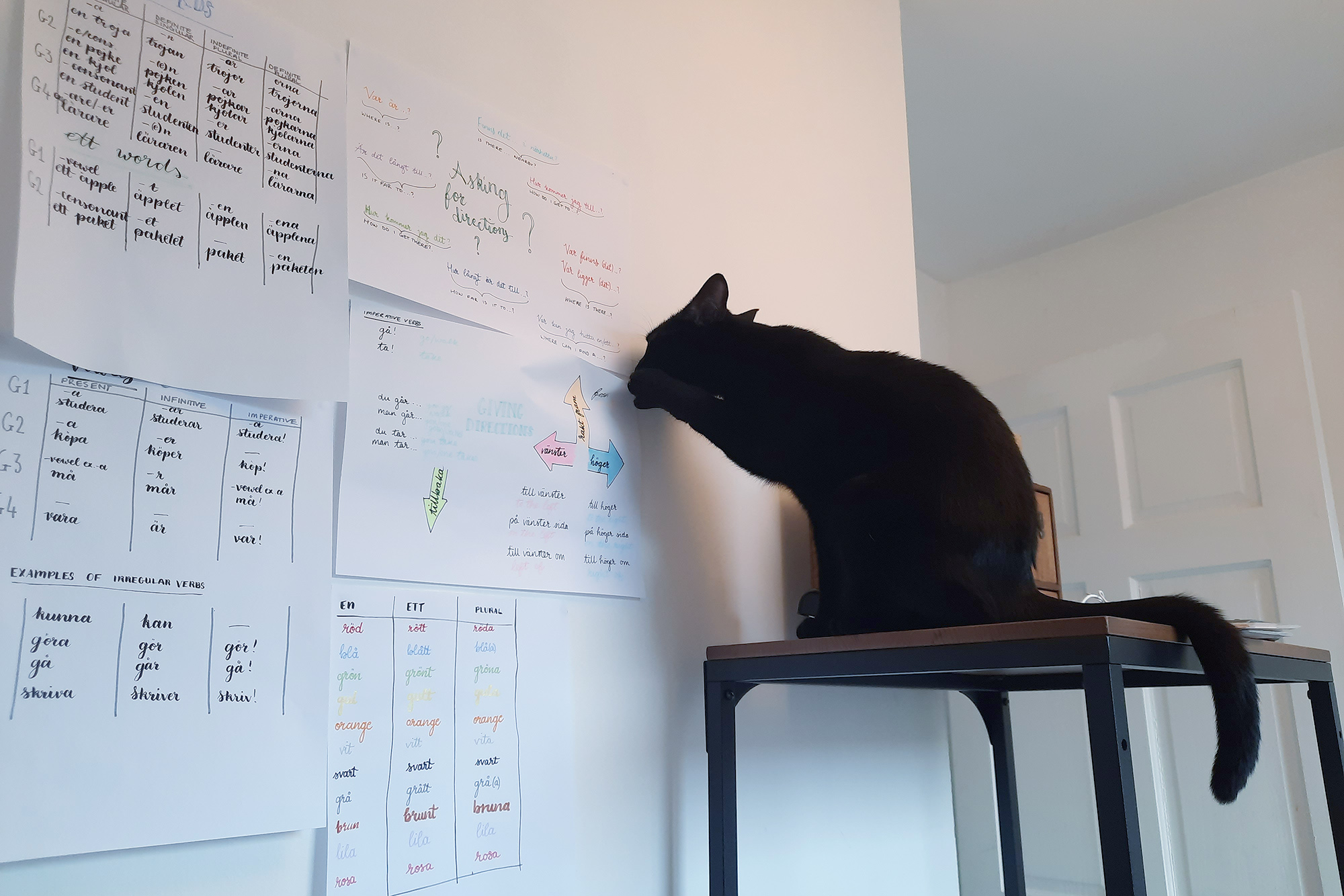I’m not the sort of person who normally makes a new year’s resolution. In the past when I’ve tried, attempts have fallen flat and I’ve forgotten exactly what my resolution was in the first place, be it to eat better or read more books.
This year, however, I decided to try to teach myself a new language. It’s less of a “new year’s resolution” and more like a “January resolution” – while others are trying Veganuary or Dry January, I’ve been attempting to teach myself Swedish using only free resources.
So why Swedish?
As a bit of background, I currently translate from three languages into English as part of my role as an Account Linguist at Sandberg. I started learning French and Spanish at secondary school, and then picked up German as a beginner at university, where I studied all three. Besides those, I’ve dabbled in Icelandic, Sanskrit and a couple of other languages over the years, aided for the most part by apps such as Duolingo and the embarrassing number of barely-touched language learning books on my shelf, but I’ve never made the foray into Swedish. Until now, that is.
Hopefully I can help you to make a start – after all, that’s the most difficult part!
I picked Swedish for a few reasons. First, there appeared to be a large number of resources out there, ranging from apps to websites describing grammar and YouTube videos about pronunciation. Second, many of my colleagues at Sandberg are either Swedish, know Swedish or have studied Swedish in the past, so I would be able to ask for help if needed. Finally, and perhaps most importantly – I wanted to be able to understand ABBA songs in their native language.
In this article, I’ll explain the free resources I’ve used and any problems I encountered while giving my opinion on the best ways to start learning a new language. It takes a lot of dedication if you’re thinking of starting a new language from scratch, but hopefully I can help you to make a start – after all, that’s the most difficult part!
Setting the ground rules
Before starting this challenge, I decided to set myself some rules:
- First of all, I would only practise for 45 minutes per day, i.e. the amount of time I would normally spend commuting on the train in the pre-COVID world. I chose this amount of time for a variety of reasons, the most important being that it is more sustainable to practise a language every single day for a short period of time rather than once or twice a week for a few hours. It also gives your brain a chance to let the new information you’ve learnt sink in, rather than overloading it with vocabulary for two hours and then forgetting everything straight away.
- Secondly, as I mentioned above, I would only be using free resources to learn Swedish, so there’d be no buying of Swedish textbooks or paying for premium versions of apps – I want to prove how it really is possible to start learning a language without spending anything.
- Finally, at the end of the month, I would need to take a test to see whether I’d managed to reach level A1 of the CEFR (Common European Framework of Reference for Languages). This is because I think it’s really important to have tangible goals in mind when learning a language.
Week 1
For the first couple of days, I didn’t have much of a plan about which resources I wanted to use. I started off with the apps that I knew already – Duolingo and Drops. If you haven’t come across either of these apps before, they basically gamify the language-learning experience, and most would agree that they are a lower-effort method of revising vocabulary and learning new words, though neither explain the grammar behind the words and phrases.
As my aim was to get to at least A1 level of Swedish by the end of the month, I quickly realised that I would need to introduce a different resource which explained both grammar and basic but useful vocabulary. This is how I came across the website Say it in Swedish. If you’re trying to learn a new language from scratch, I would advise doing some googling until you find the best resources for you – everyone has different learning styles, after all!
I ended up using Say it in Swedish throughout the entire month as my principal source of learning material. I found that each topic was explained succinctly, mixing both grammatical themes and a variety of fundamental topics such as family, colours, directions and parts of the body, all of which are really handy basics when you’re learning a language from scratch.
Where I wanted to learn more about a certain topic, I found it really useful to search for more information online, and in some cases asked questions of my patient colleagues, many of whom are already very experienced in Swedish or are native Swedish speakers themselves. This leads us nicely onto week two…
Week 2
In week 2, I decided it’d be a good idea to research the different tenses that Swedish uses, to see what I was getting into and make some notes on the basics. To my absolute horror, I discovered a new concept which isn’t used in any of the other languages I’ve learnt in the past.
Rather unhelpfully, the websites I was checking didn’t give much of an indication of when said concept (the supine form, if you are interested and want to go down a rabbit hole of confusion) should be used, or why. But luckily, working in a Nordic translation company means I had a secret weapon: people who know Swedish.
I bothered a couple of colleagues to see if anyone could offer up an explanation where the internet had failed, and I was in luck. In a few minutes, a grammatical mess that I previously had no idea about had been untangled and suddenly seemed so much clearer. It’s at this juncture that I would highly recommend that you get yourself a friendly speaker of your target language to help you through sticky situations like this – there are plenty of communities online via social media and YouTube, for example.
By the end of the week, I had expanded my vocabulary further and had a better idea of how to form grammatically correct sentences, even if these were still limited to phrases such as “jag har en svart katt och hon heter Tulip” and “det är ett stort hus”. Baby steps.

Week 3
At this point, I was starting to realise quite what I’d got myself into. Learning a language is no mean feat, especially trying to teach yourself. From scratch. Using solely free online resources. Motivation was waning and I hit a bit of a wall; the only thing keeping me from quitting was the fact that I’d committed to writing this article, and it’d be pretty embarrassing to admit that I gave up halfway through, before I’d even learnt how to ask for directions.
So I kept chugging along, incorporating some news articles in lätt Svenska (“easy Swedish”) into my routine. I found this really helped me enjoy the learning process more than I had previously, as it introduced me to a variety of new, topical themes and awoke me to where and how specific grammatical concepts are used.
Another benefit of this style of learning is that it’s slightly more intuitive, as you can make educated guesses at what specific terms may mean in English based on the surrounding vocabulary. I’d definitely recommend varying the different resources and methods when learning a new language, not only because I find it effectively combats lack of motivation, but it also helps your brain to learn to process a variety of inputs as you would in your native language.
Week 4
By the start of the final week, I felt as though I’d developed a schedule that worked well for me – I’d finish work, have a tea break, and then make a start on Swedish. I was using a mix of the different methods described above, as well as making revision posters to stick up behind my desk and developing techniques to learn vocabulary more efficiently.
My favourite way to learn vocabulary, I’ve decided, is writing down words repeatedly until they stick in my head. Sometimes you don’t need to have flashy apps and special games to learn vocabulary: if you’re anything like me, good old pen and paper does the trick!
31 January finally dawned and it was time to test myself on what I’d learnt and find out whether I had reached A1 level. I found two different online tests, which I will link to at the end of this article.
The first of these tests didn’t have any listening exercises, but it did provide questions on grammar and vocabulary, so I decided to take the results as evidence of my Swedish written comprehension and grammatical skills rather than an indicator of how “good” I was at the language on the whole. This first test gave me a result of 26 points out of 40, which apparently means that I have reached A2 level in terms of written comprehension and grammar, which was above what I expected!
However, the second test supplied some more in-depth results. It included sections on vocabulary and grammar, reading, listening, and also allows the test-taker to self-assess their writing and speaking skills. For this second test, my result averaged an A2 as well, though it dipped to A1 for listening.
Overall, I’m really proud of the results I achieved through this little experiment. While I’m yet undecided on whether I’ll continue learning Swedish in the long term, I’ve definitely learnt a lot – mainly, that consistency is key. Having spent just 45 minutes per day, every day, on learning this language and managing to reach A1/A2 level at the end of a month (in terms of comprehension at least!), I feel really accomplished and have managed to form a habit that I hope sticks with me in the future.
For anyone looking to learn a new language, whether it be Swedish or Mandarin, I truly would recommend that you try to learn a little bit every day and spend some time working out which techniques and resources work best for you. You don’t always need fancy apps or textbooks, there’s a whole world of alternative resources out there just waiting to be discovered.
? Eloise’s toolkit for learning Swedish
Apps
All are available in languages other than Swedish and have both free and paid features.




